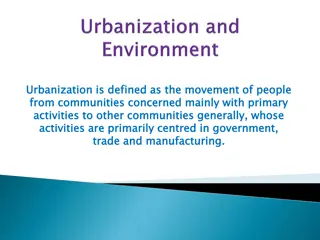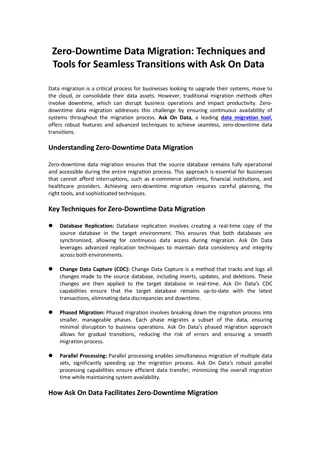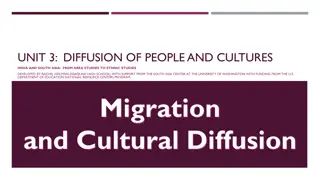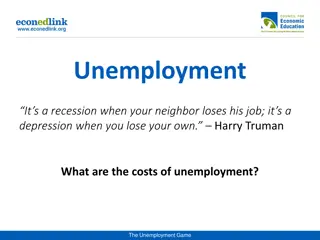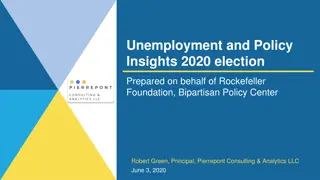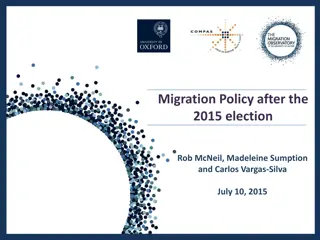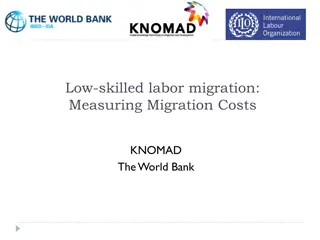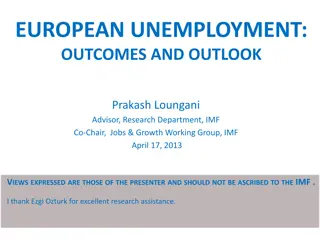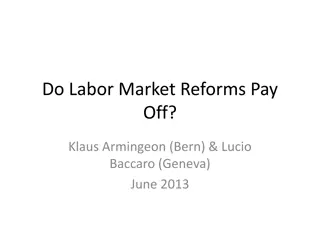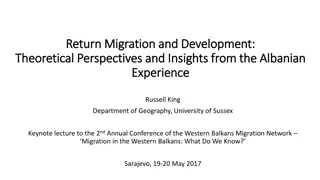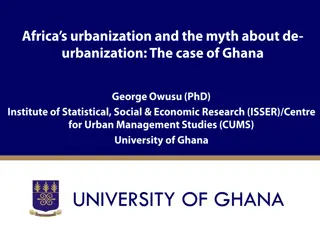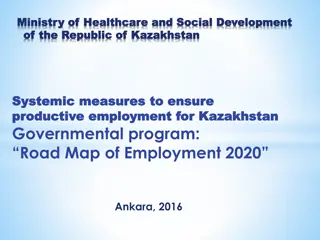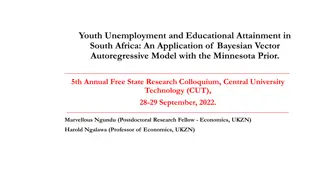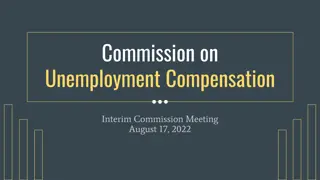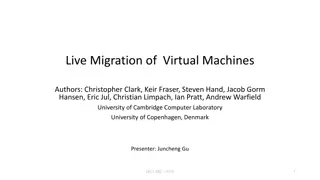Urbanization, Unemployment, and Migration: Impact on Socio-Economic Development
Urbanization, a key factor in socio-economic change, is linked to per capita income growth. The association between urbanization and development is evident worldwide, with rapid urban growth in developing countries. In Africa, high rural-urban migration and urban fertility rates drive urbanization. The stages of urbanization, from rural to urban societies, reflect varying levels of development. Cities play a crucial role in agglomeration economies, offering cost advantages to both producers and consumers.
Download Presentation

Please find below an Image/Link to download the presentation.
The content on the website is provided AS IS for your information and personal use only. It may not be sold, licensed, or shared on other websites without obtaining consent from the author.If you encounter any issues during the download, it is possible that the publisher has removed the file from their server.
You are allowed to download the files provided on this website for personal or commercial use, subject to the condition that they are used lawfully. All files are the property of their respective owners.
The content on the website is provided AS IS for your information and personal use only. It may not be sold, licensed, or shared on other websites without obtaining consent from the author.
E N D
Presentation Transcript
CHAPTER THREE 3. Urbanization, Unemployment and Migration Urbanization : refers to an increase in the proportion of people living in towns and cities. It is a major aspect of socio-economic change. In urban centers, the majority of people is engaged in non-agricultural economic activity. Urbanization and Development There is positive association between urbanization and per capita income. The more developed the country, measured by per capita income, the greater the share of population living in urban areas. 1
The highest-income countries, such as Denmark, are among the most urbanized. The very poorest countries, such as Rwanda, are among the least urbanized. Urban Population and Per Capita Income 2
Although urbanization is closely associated with economic growth, it is happening everywhere in the world whether economic growth is positive or negative. These days, there is rapid growth of cities in developing countries. In 1950, 38% of the world urban population were living in cities of the developing world. By 2010, over three-quarters of all urban dwellers are living in metropolitan areas of low- and middle-income countries. Africa is the least urbanized of all the continents in the world. Only 38% of the continent s population live in urban areas. 3
However, the continent has the worlds highest rate of urbanization, which is about 5.4% per year. Why? - Very high rate of rural-urban migration - High fertility in the urban areas Urbanization in Africa industrialization as it was in the now-developed countries. Stages of Urbanization Initial stage : rural society - represents least developing countries Transitional stage: urbanization stage - represents developing countries Terminal stage : urban society - represents developed countries is not associated with 4
Stages of Urbanization Initial Stage Terminal Stage Transition Stage 100 Demographic transition Rural to urban migration Developed countries 80 Urban Population Developing countries Rural Society Urban Society 60 40 Least developed countries 20 Urbanization 0 Time Source: Adapted from Peters and Larkin, Population Geography, 1999. 5
The Role of Cities Agglomeration economies Cities are formed because they provide cost advantages to producers and consumers. Agglomeration economies refers to cost advantages to producers and consumers from location in cities and towns. It takes two forms : Urbanization economies: agglomeration effects captured by all sectors of an economy as a result of the general growth of a concentrated geographic region. Localization economies: agglomeration effects captured by particular sectors of the economy, such as finance or automobiles, as they grow within an area. 6
Localization economies often take the form of forward and backward linkages. Forward linkage Users of outputs of an industry reduce their transportation costs by locating nearby to the industry. They can easily find a new job. Backward linkage Firms of the same or related industries may benefit from being located in the same city. B/c - They can obtain a large pool of workers with the specific skills. - They benefit from specialized infrastructure. Workers with specialized skills appropriate to the industry prefer to be located there as well so that they can easily find new job or be in a position to take advantage of better opportunities. 7
Industrial Districts and Clustering An economic definition of a city is an area with relatively high population density that contains a set of closely related activities . Firms doing similar work often prefer to be located around one place. Alfred Marshall called this industrial districts. Benefits of industrial districts: Passive collective efficiency ---location - they can learn from each other - marketing advantages Active collective efficiency -----collective action - Lobbying the government for needed infrastructure as an industry rather than as individual firms - Developing training facilities 8
Efficient Urban Scale and Congestion Costs Localization economies do not imply that it is efficient for all industries to be located together in a single city. Localization economies extend across closely related industries (those with strong backward and forward linkages). There are fewer productivity benefits for unrelated industries to locate together. Urban scale is said to be economically efficient if average costs for industries are lowest. An increase in urban density leads to congestion costs. Congestion: an action taken by one agent that decreases the incentives for other agents to take similar actions. 9
Congestion leads to : Higher costs of real estate - urban land costs become high which leads to skyscrapers Greater transportation costs - Workers travel longer distances and may demand higher wages to cover transportation costs Higher costs of infrastructure (water and sewer systems) Blackhole effect - If costs of transportation of finished goods are high, consumers are located in the largest city to avoid paying those transportation costs. Economic activities are indefinitely concentrated within a city. 10
The Urban Giantism Problem It occurs when capital cities or other urbangiants suffer from enormous levels of congestion, but adequate mid- size cities that might provide alternative locations for growth are lacking the problem of congestion. 11
Causes: the urban giantism problem is a combined effect of 1. The hub-and-spoke transportation system - In developing countries, the main transportation routes are often a legacy of colonialism. - The colonialists developed the transportation system with the aim of extraction of a country s natural resources. - In many cases, the capital cities of colonized countries are located near the outlet of this system on the seacoast. - Then, producers located and plant their firm in this area, which transportation facility is very high, and large consumers also available. - This type of transportation system is also called a hub-and- spoke system. 2. The location of the political capital in the largest city 12
A well designed infrastructure development program can alleviate the urban giantism problem; more efficient links between medium-size cities and better roads, utilities, and telecommunications within these cities However, Dictatorship provide bread and infrastructure for the first largest city to prevent unrest. - Governments policy toward the rest of the world Import substitution- leads to urban giantism-firm located nearer to the center Export promotion & low-trade barriers reduce urban giantism-firm operate nearer to the port and border Politics and Urban Concentration: % of urban population living in largest city - - 13
First-City Bias : occurs when a countrys largest or first- place city receives a disproportionately large share of public investment and incentives for private investment in relation to the country s second-largest city and other smaller cities. As a result, the first city receives a disproportionately and inefficiently large share of population and economic activity. The Urban Informal Sector and Unemployment The urban economy of developing countries is decomposed into formal and informal sectors. Informal sector: part of urban economy of developing countries characterized by small competitive individual or family firms, petty retail trade and services, labor-intensive methods, free entry, and market-determined factor and product prices. 14
Characteristics of informal sector - Individually or family-owned small scale production and service activities - Use simple and labor-intensive technology - Operate like monopolistically competitive firms - Have less formal education and are generally unskilled - Lack access to financial capital - Worker productivity and income are lower - Workers do not enjoy the measure of protection (job security, old-age pensions) - Many workers entering this sector are recent migrants from rural areas who unable to find employment in the formal sector. - They live in slums and squatter settlements, which generally lack minimal public services such as electricity, water, drainage, transportation, and educational and health services. 15
Why urban informal sector is promoted? - generates surplus despite hostile environment - creates jobs since it is labour intensive - Provides access to training and apprenticeships at lower cost - creates demand for unskilled workers - uses appropriate technologies and local resources - plays an important role in recycling waste materials - more benefits to poor, especially women who are concentrated in the informal sector With the failure of formal sectors to absorb additions to the labor force in developing countries, more attention is given to the informal sector in reducing unemployment problem. In many developing countries, about half of the employed urban population works in the informal sector. 16
Disadvantages of informal sector There is strong relationship between rural-urban migration and labor absorption in the informal sector - promoting income and employment opportunities in the informal sector could aggravate the urban unemployment problem by attracting more labor. Negative environmental consequences: many informal-sector activities cause pollution and congestion. Measures to promote the informal sector Adopting a more positive attitude toward informal sector Facilitating training Provision of credit Providing infrastructure and suitable locations for work 18
Economic Model of Rural- Urban Migration As a pattern of development, the more developed the economy, the more urbanized. Developing nations witnessed a massive rural-urban migration, i.e., they are being too rapidly urbanized. However, there is rising levels of urban unemployment and underemployment in developing countries. This combination suggests the migration and urbanization dilemma.-Todaro 1. Lewis Model Lewis model is based on a particular view of the underdeveloped economy and the development process. Lewis viewed development process as a structural change involving transformation of primarily agricultural economy to an industrial one. The engine of development is industry and development requires rapid growth of industry. The growth of industry depends on three things: 1. Capital accumulation and investment in industry 2. Availability of labor to industry 3. Availability of food to industrial workers 19
Main Assumptions of Lewis model Two-Sectors (two goods): Agriculture and Industry. Diminishing marginal productivity of labor in both sectors. Dual Economy: Underdeveloped economies are characterized by dualism which is coexistence of traditional and modern sectors. Traditional sector is characterized by backward or traditional technology and low capital intensity. The production is normally organized on the basis of family labor with overall output distributed not in the form of wages and profits, but in the form of shares that accrue to each family member. Producers in this sector maximize family income and not profit. 20
Modern sector on the other hand is characterized by advanced technology and relatively high-capital intensity. Producers in this sectors are profit maximizer s. Interaction between agriculture and industry: Agriculture supplies labor to industry and the surplus food which sustains nonagricultural labor force. In the Lewis model, agricultural sector was assumed to be the traditional sector and industry to be the modern sector. The flow of labor and food from agriculture to industry are known as two fundamental resource flows. Surplus Labor: Central to the Lewis model is the idea of surplus labor in the agricultural or traditional sector. Lewis assumed that a significant section of agricultural workers can be shifted to industry or modern sector without adversely affecting agricultural output. More formally, workers in the agricultural sector are employed even though there marginal product is zero. 21
Todaro migration model shows the paradoxical relationship between accelerated rural-urban migration and rising urban unemployment. Hypotheses: 1. Migration is an individual rational decision 2. Migration proceeds in response to urban-rural differences in expected income rather than Rural-urban migration is a rational economic decision despite the existence of high urban unemployment. Migrants calculate (present value of) expected urban income and move if this exceeds average rural income. 22
Schematic Framework for Analyzing the Rural-to-Urban Migration Decision 23
Rural-to-urban migration continues despite there exists high urban unemployment. Although it is privately rational for an individual to migrate to the city despite high urban unemployment, it is socially very costly. The Todaro migration model has four basic characteristics: 1. Migration is stimulated primarily by rational economic considerations of relative benefits and costs of urban sector. 2. The decision to migrate depends on expected urban-rural real-wage differentials where the expected differential is determined by the actual urban-rural wage differential and the probability of successfully obtaining employment in the urban sector. 27
3. The probability of obtaining an urban job is directly related to the urban employment rate and thus inversely related to the urban unemployment rate. 4. Rural-urban migration rates in excess of urban job opportunity growth rates are rational and possible when there is wide urban-rural expected income differentials . Five Policy Implications 1. Reduction of imbalances opportunities in rural and urban sectors. 2. Improvement of rural economic opportunities Urban job creation is not sufficient solution for the urban unemployment problem. The creation of more urban jobs without improving rural incomes and employment opportunities can result in higher levels of urban unemployment. between economic 28
The Process in which the creation of urban jobs raises expected incomes and induces more people to migrate from rural areas is known as induced migration. 3. Curtailing public investment in higher education Educational expansion will lead to further migration and unemployment. If the probability of success in securing a modern-sector job is higher for people with more education, their expected income differential will be higher, and they will be more likely to migrate to the cities. 4. Elimination of wage distortions Actual urban wages generally exceed the market or correct wage as a result of a variety of institutional factors. 5. Encouraging integrated rural development programs. 29
Policies need to focus on the urban employment and supply of labor in rural areas. A Comprehensive Migration and Employment Strategy - policy approaches designed to improve the very serious migration and employment situation in developing countries: 1. Creating an appropriate rural-urban economic balance 2. Expansion of small-scale, labor-intensive industries 3. Eliminating factor price distortions 4. Choosing appropriate labor-intensive technologies of production 5. Modifying the linkage between education and employment 6. Reducing population growth 7. Decentralizing authority to cities and neighborhoods 30
Quiz (5%) 1. What is the difference between Lewis and todaro s migration model? 2. Why the migration and urbanization dilemma arise? 31


